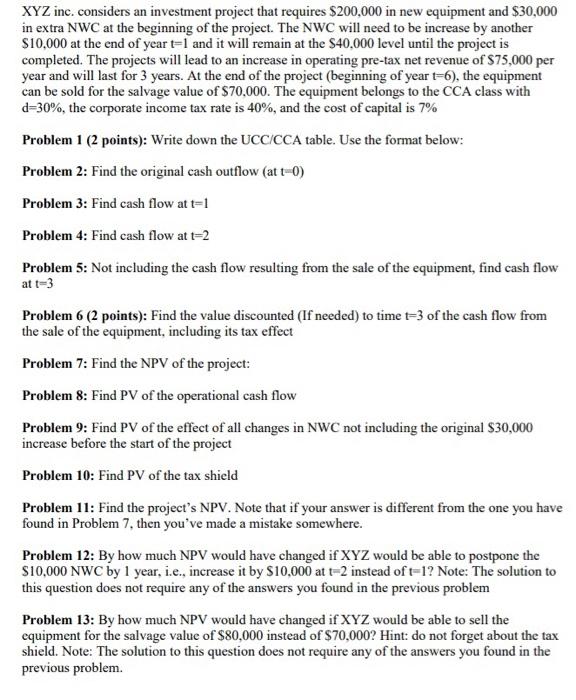All interest rates are assumed to be compounded annually unless stated otherwise. XYZ inc. considers an investment project that requires $200,000 in new equipment and $30,000 in extra NWC at the beginning of the project. The NWC will need to be increase by another $10,000 at the end of year t=1 and it will remain at the $40,000 level until the project is completed. The projects will lead to an increase in operating pre-tax net revenue of $75,000 per year and will last for 3 years. At the end of the project (beginning of year t-6), the equipment can be sold for the salvage value of $70,000. The equipment belongs to the CCA class with d=30%, the corporate income tax rate is 40%, and the cost of capital is 7% Problem 1 (2 points): Write down the UCC/CCA table. Use the format below: Problem 2: Find the original cash outflow (at t-0) Problem 3: Find cash flow at t=1 Problem 4: Find cash flow at t=2 Problem 5: Not including the cash flow resulting from the sale of the equipment, find cash flow at t=3 Problem 6 (2 points): Find the value discounted (If needed) to time t=3 of the cash flow from the sale of the equipment, including its tax effect Problem 7: Find the NPV of the project: Problem 8: Find PV of the operational cash flow Problem 9: Find PV of the effect of all changes in NWC not including the original $30,000 increase before the start of the project Problem 10: Find PV of the tax shield Problem 11: Find the project's NPV. Note that if your answer is different from the one you have found in Problem 7, then you've made a mistake somewhere. Problem 12: By how much NPV would have changed if XYZ would be able to postpone the $10,000 NWC by 1 year, i.e., increase it by $10,000 at t-2 instead of t=1? Note: The solution to this question does not require any of the answers you found in the previous problem Problem 13: By how much NPV would have changed if XYZ would be able to sell the equipment for the salvage value of $80,000 instead of $70,000? Hint: do not forget about the tax shield. Note: The solution to this question does not require any of the answers you found in the previous problem. All interest rates are assumed to be compounded annually unless stated otherwise. XYZ inc. considers an investment project that requires $200,000 in new equipment and $30,000 in extra NWC at the beginning of the project. The NWC will need to be increase by another $10,000 at the end of year t=1 and it will remain at the $40,000 level until the project is completed. The projects will lead to an increase in operating pre-tax net revenue of $75,000 per year and will last for 3 years. At the end of the project (beginning of year t-6), the equipment can be sold for the salvage value of $70,000. The equipment belongs to the CCA class with d=30%, the corporate income tax rate is 40%, and the cost of capital is 7% Problem 1 (2 points): Write down the UCC/CCA table. Use the format below: Problem 2: Find the original cash outflow (at t-0) Problem 3: Find cash flow at t=1 Problem 4: Find cash flow at t=2 Problem 5: Not including the cash flow resulting from the sale of the equipment, find cash flow at t=3 Problem 6 (2 points): Find the value discounted (If needed) to time t=3 of the cash flow from the sale of the equipment, including its tax effect Problem 7: Find the NPV of the project: Problem 8: Find PV of the operational cash flow Problem 9: Find PV of the effect of all changes in NWC not including the original $30,000 increase before the start of the project Problem 10: Find PV of the tax shield Problem 11: Find the project's NPV. Note that if your answer is different from the one you have found in Problem 7, then you've made a mistake somewhere. Problem 12: By how much NPV would have changed if XYZ would be able to postpone the $10,000 NWC by 1 year, i.e., increase it by $10,000 at t-2 instead of t=1? Note: The solution to this question does not require any of the answers you found in the previous problem Problem 13: By how much NPV would have changed if XYZ would be able to sell the equipment for the salvage value of $80,000 instead of $70,000? Hint: do not forget about the tax shield. Note: The solution to this question does not require any of the answers you found in the previous








